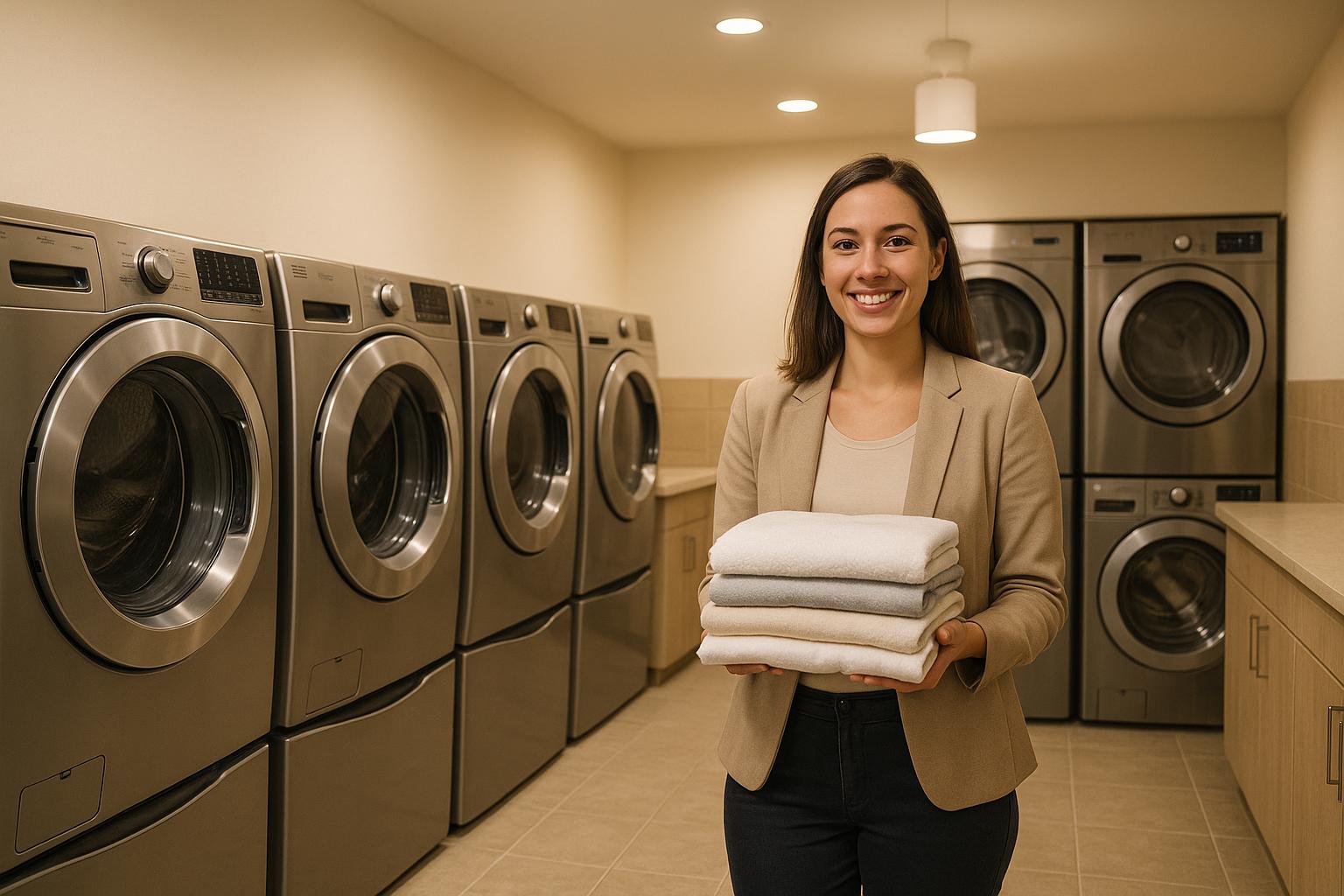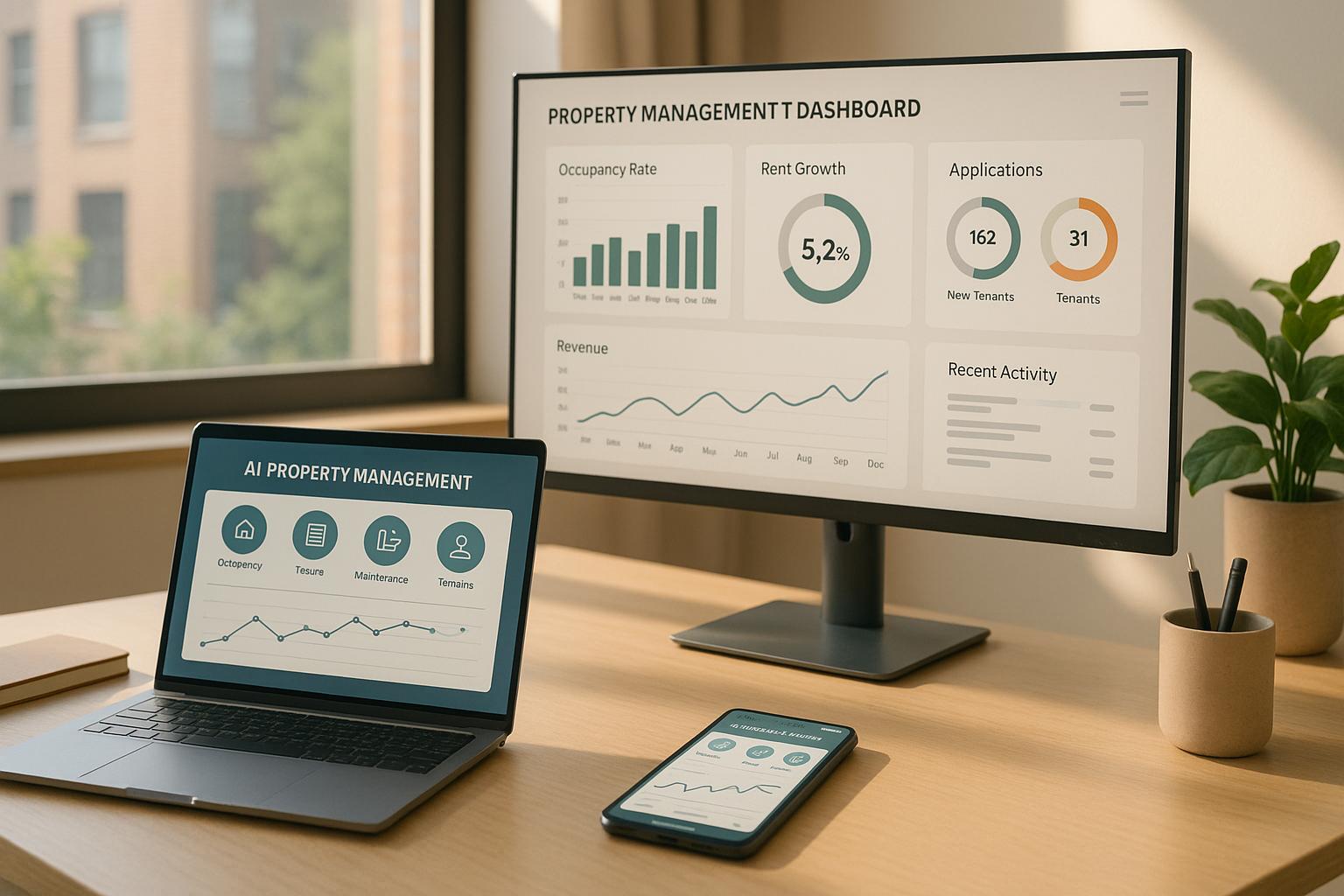Revenue sharing models for laundry services in multifamily housing provide property managers with a low-risk way to generate income while offering residents a convenient amenity. Here's the basic idea: a laundry service provider installs and maintains washers and dryers, and the property manager provides space and utilities. Revenue from residents' use is typically split, often 50/50. This arrangement eliminates upfront costs for property owners and reduces management effort, while still delivering steady income.
Key points:
- Common Models: Route model (revenue split, often 50-70% for property owners), fixed lease (guaranteed income), and hybrid agreements (base fee + revenue percentage).
- Typical Revenue Split: Property owners may earn 50-70%, depending on usage and contract terms.
- Key Contract Terms: Focus on equipment specs, maintenance response times, insurance, termination clauses, and revenue definitions.
- Benefits: No upfront investment, steady income, and reduced operational burden.
- Drawbacks: Long-term contracts, shared revenue, and limited pricing control.
Quick Tip: Negotiate hybrid deals or shorter terms to maximize flexibility and income potential. Use technology to monitor revenue, track machine performance, and ensure transparency.
Revenue sharing is ideal for properties wanting hassle-free income, but those with higher management capacity might benefit more from owning their laundry facilities.
John Steinhofer edited
Common Revenue Sharing Models and Arrangements
Property managers often navigate various revenue-sharing models, each with its own financial dynamics and risk levels. Grasping these differences is key before committing to a contract.
Route Model Revenue Sharing
The route model is one of the simplest setups in multifamily laundry services. Here, vendors take care of installing commercial laundry machines without charging any upfront fees [2]. They also handle maintenance, repairs, and revenue collection, while the property owner provides the space and covers utility costs.
Revenue splits in this model usually favor property owners, with shares typically ranging from 50% to 70% of the monthly income [7]. Smaller properties or those with lower usage often settle for an even 50/50 split [5]. Matt Miller shared an example of how this model works, noting that the property's commission matched its previous gross income from self-managed laundry operations [5]. As he explained:
"With revenue sharing, we actually pay the property owner." [5]
This model is ideal for properties looking to avoid the hassle of maintenance and upfront costs. Vendors also provide flexible payment systems, such as coin, card, and mobile payment options [3].
Fixed Lease vs. Percentage-Based Revenue Sharing
Property managers typically choose between fixed lease payments and percentage-based revenue-sharing agreements. Each comes with its own set of advantages and challenges.
Fixed lease agreements offer consistent, predictable income regardless of how much the laundry machines are used [7]. In this setup, the property either pays a set monthly fee to the laundry company while keeping all the revenue or receives a fixed rental payment from the vendor, who then keeps all machine income [6][7].
Percentage-based revenue sharing, on the other hand, ties the property’s income to actual usage. The property typically earns 50% to 70% of the revenue, as noted earlier [7]. Some arrangements combine both approaches, where the laundry company pays a base rental fee and adds a percentage of revenue once monthly collections exceed a certain amount [7].
Here’s a quick comparison of these models:
| Model Type | Property Income | Revenue Predictability | Upside Potential |
|---|---|---|---|
| Fixed Lease | Guaranteed monthly amount | High | Limited |
| Percentage-Based | 50-70% of collections | Variable | High |
| Hybrid | Base fee + percentage | Moderate | Moderate |
These models shape the terms of agreements, which we’ll explore further.
Contract Lengths and Standard Clauses
Having a solid understanding of these models lays the groundwork for negotiating contract terms that define roles and expectations. Laundry service agreements often span between 5 and 10 years, giving vendors enough time to recover their equipment costs while ensuring steady income for property owners. Contracts frequently include automatic renewal clauses unless one party provides written notice 60 to 90 days before the expiration date. Property managers should negotiate renewal terms to account for market changes and potential equipment upgrades.
Termination clauses are another key consideration. Some contracts impose penalties for early termination, while others allow termination for cause without added costs. It’s crucial to review these clauses carefully, including details about equipment removal and any related expenses.
As laundry technology advances, equipment upgrade provisions have become increasingly important. Many contracts now include terms requiring vendors to update payment systems or replace outdated machines at set intervals. Cardinal Laundry Leasing, for instance, highlights this in their agreements:
"Our revenue-sharing contracts provide a win-win solution for property owners. By partnering with Cardinal Laundry Leasing, you can enjoy a steady stream of income from your laundry facilities without any upfront investment." [4]
Well-defined contracts help property managers maximize the benefits of revenue-sharing models. Standard clauses typically cover utility responsibilities, maintenance response times, revenue reporting schedules, and dispute resolution processes. Including specific maintenance standards and response timelines can minimize resident frustrations and reduce equipment downtime.
Contract Terms and Negotiation Strategies
Getting a handle on contract details and negotiation techniques can make a huge difference for property managers. It’s the line between securing a partnership that boosts profits or one that drains resources for years. Those who grasp these elements often lock in better deals and sidestep common mistakes.
Core Contract Elements
A well-crafted revenue-sharing contract should include provisions that safeguard your interests. Here are the key components to focus on:
- Equipment specifications: Insist on brand-new machines instead of refurbished ones. This ensures reliability and keeps residents happy [7].
- Service response times: Set a 24- to 48-hour response window for urgent issues to minimize downtime [7].
- Indemnification clause: Shift liability for injury claims from property owners to vendors [7].
- Commercial general liability insurance: Require vendors to carry insurance that covers claims without dipping into your property’s coverage [7].
- Performance clause: Make sure the contract includes provisions for replacing machines that break down or underperform [7].
- Change of ownership and demolition clause: Allow for contract termination if the property is sold or demolished [7].
Revenue definitions and how it’s calculated should also be crystal clear. Spell out what counts as revenue, how it’s measured, and include regular reporting and auditing to avoid disputes [1].
By covering these bases, you can turn contract terms into tools that protect your revenue.
Negotiation Tips for Property Managers
Knowing your leverage and understanding the vendor’s motivations are crucial. Legal experts Adam Leitman Bailey and Dov Treiman stress the importance of contract structure:
"The most powerful weapon for negotiating the most favorable agreement is to use a license agreement instead of a lease." [7]
License agreements give property owners more control, allowing them to revoke agreements "at will" and remove defaulting licensees without lengthy legal battles. In contrast, leases often require drawn-out litigation [7].
Here are some strategies to consider during negotiations:
- Revenue optimization: Negotiate hybrid deals that combine fixed rental fees with a percentage of revenue. Some managers even secure agreements where vendors keep revenue up to a set amount ("remuneration"), sharing anything above that threshold [7].
- Contract length: Push for shorter terms with better revenue splits. This gives you flexibility to renegotiate as market conditions evolve [7].
- Performance incentives: Tie revenue shares to metrics like machine uptime, response times, or resident satisfaction. This motivates vendors to maintain high service standards [7].
- Equipment upgrades: Specify energy-efficient machines and include clauses for regular technology updates to cut utility costs [7].
- Amenity add-ons: Negotiate extras like folding tables, drying racks, or seating areas as part of the vendor’s installation package [7].
Bailey and Treiman also emphasize the bigger picture:
"Savvy business owners should not regard their laundry rooms as mere icing on the revenue stream cake...the insistence on some basic principles can simultaneously increase the building's income and hedge its liabilities and losses." [7]
With these tactics, you can secure agreements that not only enhance revenue but also protect against potential losses.
Using Technology for Transparency and Accountability
Once you’ve nailed down the contract, technology can help ensure everything runs smoothly and transparently. It’s a game-changer for tracking revenue and improving operations.
- Real-time revenue reporting: Digital platforms let you monitor daily income instead of waiting for monthly statements. These tools also provide detailed insights into machine usage, payment methods, and peak activity times.
- Mobile payments and automated reporting: Systems that integrate mobile payment options create clear, auditable transaction records. Monthly reports become easier to manage, offering standardized breakdowns of gross revenue, percentage splits, and net payments.
- Remote monitoring: Vendors can keep an eye on machine performance and anticipate maintenance needs. Make sure you negotiate access to this data so you can verify proactive maintenance efforts.
- Audit rights: Include clauses that grant you access to digital records and reporting systems for periodic audits. Technology simplifies the process, but the contract must explicitly allow it.
sbb-itb-58157f8
Pros and Cons of Revenue Sharing Models
Revenue sharing models offer property managers a practical way to enhance their services, but they come with their own set of challenges. Weighing the benefits and drawbacks can help you decide if this approach aligns with your financial and operational goals.
Benefits of Revenue Sharing
One of the biggest perks is skipping the hefty upfront investment. Property managers can install professional-grade laundry facilities without the financial strain of buying equipment outright. Plus, these facilities can generate steady income, often contributing 10% or more to annual revenue [8]. This setup can also help property owners cover service costs without raising rent, making base rent more appealing to potential tenants [8].
Another advantage is the hands-off maintenance. Vendors typically handle repairs, replacements, and equipment upgrades, easing the operational load for property managers. These benefits make revenue sharing an attractive option, especially for properties with limited capital or management resources.
Drawbacks of Revenue Sharing
However, the trade-offs are worth noting. While you avoid upfront costs, you also give up a share of the ongoing revenue - profits you could keep entirely if you managed the facilities yourself. Many agreements also involve long-term contracts, which can limit your flexibility to adapt to market changes. Attorney Adam Leitman Bailey highlights this issue:
"Building owners and managers often generate revenue from residential tenants while at the same time leaving themselves to the will and whim of laundry room operators who impose contracts lasting for decades with automatic renewals, rights of first refusal and other one-sided provisions." [7]
Additionally, revenue sharing can restrict your control over pricing, making it difficult to adjust rates in response to market trends.
Comparison Table: Benefits vs. Drawbacks
| Pros | Cons |
|---|---|
| No upfront investment required | Long-term contracts may limit flexibility |
| Equipment, service, and support included | Utility costs are often still covered by the property |
| Steady monthly income | You share, rather than keep, 100% of the revenue |
| Improved tenant satisfaction | Limited pricing control |
Ultimately, your choice should depend on your property's financial situation, management capacity, and long-term goals. If you have limited capital or prefer a low-maintenance option, revenue sharing can be a smart move. On the other hand, if your property generates significant income and you have the resources to manage operations, owning and operating your laundry facilities might be a better fit. The next section will offer practical tips to help you make the most of revenue-sharing agreements.
Best Practices for Multifamily Property Managers
Boost your property's financial performance and streamline operations by adopting revenue-sharing models with carefully chosen vendors. Success starts with selecting partners whose services align with your property's specific goals.
Begin with a detailed vendor evaluation. When assessing laundry service providers, dig into the details. Ask about contract terms, revenue-sharing percentages, repair protocols, plans for equipment upgrades, revenue tracking systems, and procedures for handling property sales [1]. While revenue splits matter, reliability and service quality should take priority. Look for vendors offering modern machines, digital payment options, and quick responses to maintenance requests [1][9].
Monitor vendor performance from day one. Effective agreements often include centralized dashboards that provide real-time data on machine usage, service needs, and revenue metrics [11]. These tools allow you to spot issues early - like declining usage, frequent breakdowns, or revenue inconsistencies - and ensure quick responses to service needs. This improves resident satisfaction and keeps operations running smoothly.
Review contracts regularly. Just like rental rates, vendor agreements should be revisited periodically to stay competitive [10]. Schedule annual contract reviews to ensure terms, including revenue splits, align with current market standards.
Negotiate strategically. Don’t settle for the first offer. Vendors typically anticipate some negotiation. Focus on securing terms that cover essentials like equipment upgrades, quick maintenance responses, and flexible contract conditions. Instead of solely pushing for higher revenue splits, consider how rising operating costs impact your bottom line and negotiate agreements that balance cost control with quality service [10].
Building a strong relationship with your laundry vendor is essential. Treat them as a partner rather than just a service provider. Open communication, clear expectations, and accountability are key to fostering a partnership that improves both financial results and resident satisfaction. By following these practices, property managers can create a stable foundation for sustained revenue growth.
FAQs
What should property managers consider when deciding between a fixed lease or a percentage-based revenue-sharing model for laundry services?
When choosing between a fixed lease and a percentage-based revenue-sharing model for laundry services, property managers should weigh several important factors:
- Steady income vs. variability: Fixed leases guarantee a consistent monthly payment, providing predictable revenue. In contrast, percentage-based models tie income to laundry usage, which can vary month to month.
- Upfront costs and responsibilities: Fixed leases often involve higher initial payments but reduce ongoing involvement. On the other hand, revenue-sharing models usually come with lower upfront costs but may require you to share in maintenance responsibilities.
- Risk and earning potential: Fixed leases offer financial stability throughout the contract, while percentage-based models present an opportunity for higher earnings if tenant usage increases. However, this comes with the uncertainty of fluctuating income.
To make the best choice, consider your property's laundry usage trends, financial objectives, and how much involvement you're willing to take on.
What steps can property managers take to ensure accurate and transparent revenue reporting from laundry service providers?
To keep revenue reporting precise and transparent, property managers can adopt a few effective strategies. One option is to use smart laundry systems that offer real-time data and usage analytics, making it easier to track revenue and assess performance. Regular reviews of financial records combined with periodic audits can also help uncover and address any inconsistencies. A centralized dashboard can further simplify management by providing a clear view of machine usage and revenue trends, streamlining oversight and boosting accountability.
Establishing open communication with your laundry service provider is equally important. Clearly outlining reporting expectations in your contract can set the foundation for a more transparent and cooperative relationship.
What strategies can property managers use to negotiate better terms in revenue-sharing contracts for laundry services?
To improve your chances of securing better terms in revenue-sharing contracts for laundry services, start by diving into industry standards. Familiarize yourself with typical revenue splits, contract durations, and service expectations. This groundwork gives you a solid foundation to set realistic goals and approach negotiations with confidence.
Emphasize the value of a long-term partnership by showcasing how both parties can benefit - think steady revenue streams and happier tenants. Come prepared with a flexible proposal that clearly states your priorities but leaves room for adjustments. Using proven techniques like anchoring (setting the initial offer to guide the negotiation) and having a strong BATNA (Best Alternative to a Negotiated Agreement) ensures you maintain leverage and aren’t overly dependent on one deal.
Finally, don’t skip the fine print. Carefully review all contract terms, especially those related to maintenance duties, revenue payout schedules, and renewal conditions. This attention to detail can save you from unexpected issues down the road.


